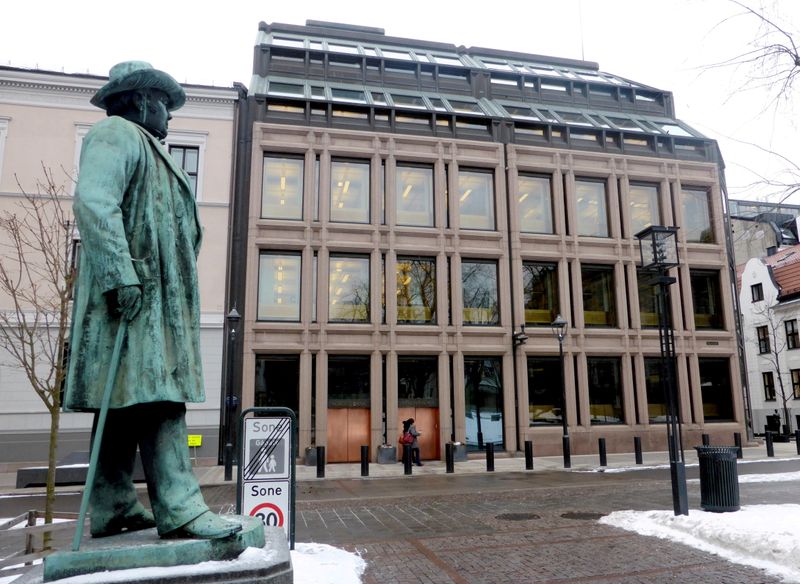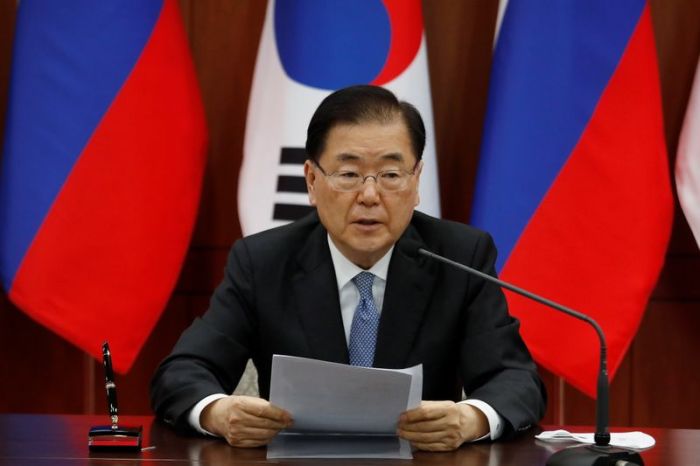By Victoria Klesty and Nerijus Adomaitis
OSLO (Reuters) -Norway’s central bank raised its benchmark interest rate on Thursday and said it expects to hike again in December, as it joins a short but growing list of nations moving away from emergency-level borrowing costs.
Norges Bank’s monetary policy committee raised the sight deposit rate to 0.25% from a record low of zero, as forecast unanimously https://www.reuters.com/article/norway-economy-rates-idUSL8N2QG31X in a Reuters poll of analysts and in line with the central bank’s own plan https://www.reuters.com/article/norway-economy-rates-idUSL8N2PQ1WQ.
“There is a strong recovery in the Norwegian economy,” Norges Bank Governor Oeystein Olsen told a news conference. “It’s time to start a gradual normalisation of the policy rate.”
The monetary policy committee said its forecast for four more hikes by the end of 2022, to a rate of 1.25%, had become even more likely.
Norway’s currency, the crown, strengthened to 10.0830 against the euro at 1025 GMT from 10.1031 just before the announcement.
Many of the world’s central banks are now laying the groundwork for a transition to life with less stimulus, and some developed economies have already raised rates, such as the Czech Republic https://www.reuters.com/article/czech-economy-rates-idUSL8N2PC69R, South Korea https://www.reuters.com/business/finance/skorea-seen-delivering-its-first-pandemic-era-rate-hike-2021-08-25 and Iceland.
In the United States, the Federal Reserve on Wednesday said it will likely begin reducing its monthly bond purchases as soon as November https://www.reuters.com/business/finance/fed-likely-open-bond-buying-taper-door-hedge-outlook-2021-09-22 and signalled interest rate increases may follow more quickly than expected.
PANDEMIC
Norway’s central bank cut rates three times in 2020 to combat the impact of the COVID-19 pandemic, contributing to a boom in housing prices as borrowers took advantage of cheap credit.
The government in recent months removed most lockdown restrictions however and unemployment has fallen more than expected, while the central bank’s own business survey showed a rise in activity https://www.reuters.com/world/europe/norway-business-activity-rises-bottlenecks-emerge-2021-09-14 and pointed to growing capacity constraints.
Norges Bank’s announcement represented “yet another hawkish tilt” on monetary policy, Nordea Markets said in a note.
While a recent rise in electricity prices could reduce households’ disposable income, Norway’s high savings rate would likely take much of the sting out of rising power bills, Norges Bank added.
Asked what Norges Bank would do if winter electricity prices rose “considerably” from where future contracts are currently trading, Olsen told Reuters changes to the price levels in general were always on the bank’s radar.
He declined to comment on how much higher prices would need to climb for them to affect the rate outlook.
STRONG RECOVERY
“I think it’s perfectly reasonable (to hike interest rates) because the Norwegian economy is recovering strongly,” said Kjersti Haugland, chief economist at DNB Markets.
“It’s more about the long-term picture, how strong the economic growth and utilisation will be in a year-and-a-half from now.”
“If energy prices are extremely high this winter, Norges Bank would probably have to delay the pace (in rising interest rates) a little bit, but that’s the worst case scenario.”
Having contracted by 2.5% in 2020, the Norwegian economy is now expected to grow 3.9% in 2021, the bank said, more than the 3.8% it predicted three months ago, and will likely see expand 4.5% next year, stronger than its previous forecast of 4.1%.
Norges Bank also said it would force banks to hold more supplementary buffer capital, 2.0% of its balance sheet instead of 1.5%, boosting the system’s solidity while making less capital available for lending.
Over time, the demand will be raised to 2.5%, it added.
(Writing by Terje Solsvik, editing by Gwladys Fouche and Hugh Lawson)

























